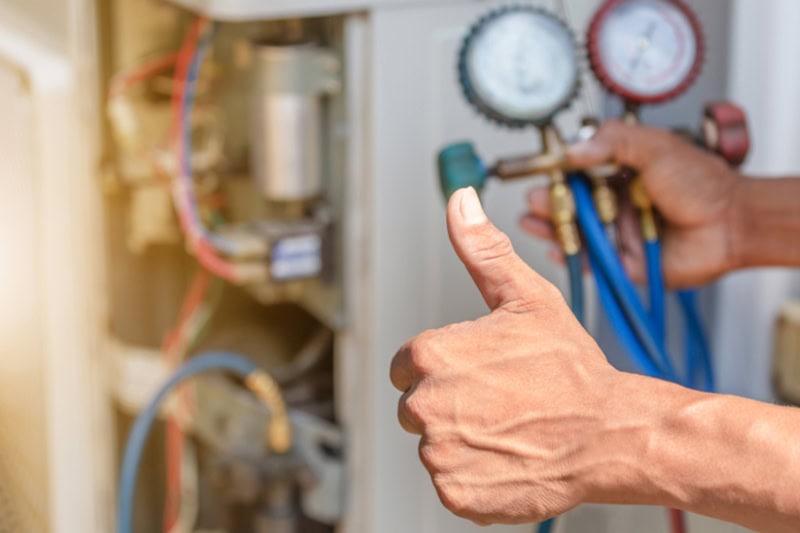Give Your Marine HVAC in Texas Some TLC

Ahoy, boat lovers!
Do you dread going below deck in sweltering heat? Or long for your furnace at home while cruising on a chilly evening?
At Innovative Air Solutions, we understand you deserve comfort on land and sea. Your boat’s HVAC system should provide the comfort you need while on the water and deliver smooth sailing for onboard temperature control.
Dive into Marine HVAC
If you are new to boating, you may not know that you can install an HVAC unit on your vessel, ensuring the same level of comfort you expect in your Orange, home.
Although boat manufacturers offer marine HVAC on some models, especially yachts, it is not a standard feature on all watercraft. If you bought a new or used cabin cruiser or cuddy cabin boat without heating and cooling, you can retrofit it with HVAC.
Ask our expert team at Innovative Air Solutions about installing a marine air conditioner in your boat.
Air Conditioning Below Deck
A reliable cooling system is a lifesaver when the temperature rises. Sometimes, being on deck in the wind and water spray can be enough to cool you off, but in calm water, with a relentless sun overhead and mild wind at your back, your quarters below deck may feel like an oven. Here are a few ways to make your cabin more comfortable:
Self-Contained: These systems house a compressor, condenser, and evaporator in one unit. They are compact and often reside under a bunk or in a locker, making them a popular choice for smaller and mid-sized boats. Some air conditioners have a reverse cycle, enabling them to heat.
Split Systems: These are similar to residential split systems, which include an evaporator coil and fan indoors and a compressor and condenser in one unit outdoors. On a boat, the condenser unit is typically installed in the engine room, and the evaporator unit is in the living area below deck. Split systems are quieter and ideal for larger recreational boats.
Chilled Water Systems: These systems circulate chilled water through piping to individual air handlers in different zones on the boat. This type of system is ideal for larger boats or yachts.
Heat Your Boat
A nip in the evening air can cut your boating season short, but onboard heating can provide comfort during even the chilliest weather. Here are a few options:
Forced Air: A furnace heats air, which flows into cabin spaces through ductwork. Propane or diesel fuel powers the equipment.
Hydronic: These units are similar to chilled water systems. They circulate heated water through pipes to radiators and fan coils, providing consistent heat.
Electric: Portable or fixed electric heaters are a simple solution for smaller boats, especially when docked and power is available. However, their high power consumption makes them impractical for extended use on the water.
HVAC and Boat Size
Small, medium, and large boats with cuddy or full cabins below deck are candidates for marine HVAC. Even boats as small as 25 to 30 feet can be outfitted with a heating and cooling system. They typically use self-contained units, which take up less space than split or chilled water systems. Smaller vessels also have lower heating and cooling demands.
As boat size increases, heating, cooling, and zoning demand grow, making split and chilled water systems more appealing.
Although marine AC units are popular, especially in warm climates, heating systems are gaining traction because they help extend the cruising season in areas with cooler temperatures.
Marine HVAC Installation
Installing a marine HVAC system is rarely a one-day project. Depending on the size and complexity of the system and the boat’s layout, it can take anywhere from a few days to a week or more to complete. Factors like ductwork runs and through-the-hull fittings can extend the timeline.
Marine HVAC Repair
Marine HVAC can malfunction just like residential heating and cooling. Some common issues include:
Clogged Intake: If marine growth or debris restricts water flow to the unit, the condenser can overheat and shut down.
Refrigerant Leaks: Vibrations and corrosion can cause refrigerant lines to leak, affecting cooling capability.
Electrical Problems: Corrosion can affect wiring and connections, leading to unreliable operation or failure.
Dirty Filters and Coils: Dust, sea salt, and mildew can accumulate on filters and coils, reducing airflow and efficiency.
Marine HVAC Warning Signs
If the airflow is weak or nonexistent, a clogged filter could be the culprit. Also, check for a ductwork issue or a faulty blower motor. If the airflow is strong but heating and cooling are insufficient, a refrigerant leak or compressor problem may be the cause.
Grinding, rattling, or hissing sounds can indicate mechanical problems, and excessive condensation can signal a drainage or evaporator coil issue.
Depending on the issue, repairs can range from simple fixes like replacing a filter to complex repairs and component replacements. Let only qualified marine HVAC technicians diagnose and repair your system. They have the training, experience, professional tools, and the correct marine HVAC parts to restore your boat’s comfort system.
Marine HVAC Maintenance
Regular preventative maintenance keeps your marine HVAC shipshape. We recommend an annual tune-up before boating season gets underway. A professional tune-up typically includes:
- Checking refrigerant level and pressure
- Cleaning coils
- Testing electrical components and inspecting connections for corrosion
- Flushing the cooling system
- Cleaning condensate drains
- Checking system performance and airflow
As a boat owner, you can contribute to its upkeep by regularly inspecting and replacing the air filter, clearing the seawater intake strainer, and inspecting ductwork and vents for damage.
Prioritize Comfort on Your Boat in Orange
Investing in a well-maintained marine HVAC system means more enjoyable and comfortable days and nights on the water. At Innovative Air Solutions, we can help you navigate onboard heating and cooling solutions. Call us at 409-231-3322 or request service online.
